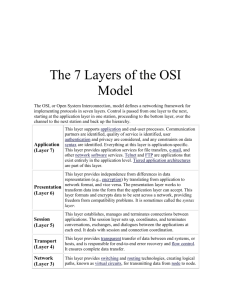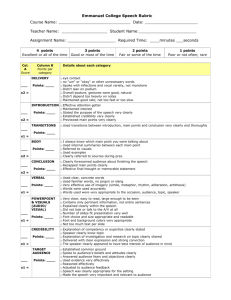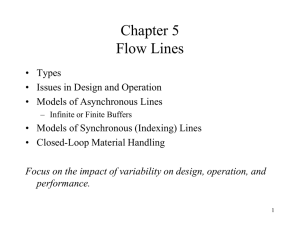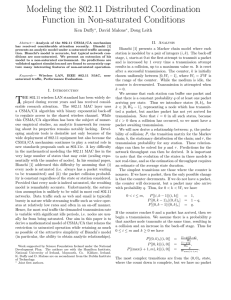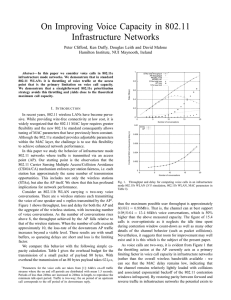Verification of Common 802.11 MAC Model Assumptions Hamilton Institute, NUI Maynooth, Ireland.
advertisement
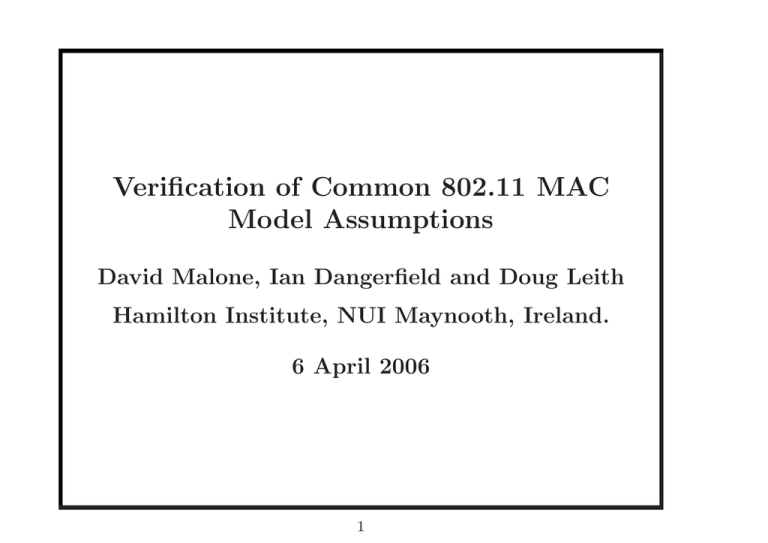
Verification of Common 802.11 MAC Model Assumptions David Malone, Ian Dangerfield and Doug Leith Hamilton Institute, NUI Maynooth, Ireland. 6 April 2006 1 Motivation • Lots of 802.11 modeling work. • Modeling has been quite successful. • However, models make simplifying assumptions. • Theory to justify assumptions has proven hard. • Can measurement help? 2 802.11 Summary • After TX choose rand(0, CW − 1). • Wait until medium idle for DIFS(50µs), • While idle count down in slots (20µs). • TX when counter gets to 0, ACK after SIFS (10µs). • If ACK then CW = CWmin else CW∗ = 2. 3 Assumptions Data Ack Collision • Time is slotted. • Stations transmit in a slot independently. • Transmission/Collision probabilities fixed. • 1 − p = (1 − τ )n−1 . • S= Ep nτ (1−τ )n−1 . σ(1−τ )n +Ts nτ (1−τ )n−1 +(1−(1−τ )n −nτ (1−τ )n−1 )Tc 4 What Can We Test? • We can measure delay, collisions and throughputs. • Are cards close to 802.11? • Is the timing good enough to slot time? • Is collision probability really fixed? • Does throughput formula work out? 5 Card timing 0.025 Fraction of Packets 0.02 0.015 0.01 0.005 0 900 1000 1100 1200 1300 Delay (seconds x 10-6) 6 1400 1500 1600 • 32 Uniform peaks, within jitter. • Stefano, et al show not all cards so well behaved. • Card trying to follow standard, timing plausible. • Now look at collision probabilities. • Use synthetic Poisson arrivals. • Fixed number of stations. 7 Two Stations 0.06 0.05 Average P(col) P(col on 1st tx) P(col on 2nd tx) 1.0/32 1.0/64 Probability 0.04 0.03 0.02 0.01 0 100 200 300 400 500 600 Offered Load (per station, pps, 496B UDP payload) 8 700 800 Ten Stations 0.3 0.25 Probability 0.2 0.15 0.1 0.05 Average P(col) P(col on 1st tx) P(col on 2nd tx) 0 40 60 80 100 120 140 Offered Load (per station, pps, 486B UDP payload) 9 160 180 • Collision probability not constant. • First stage dominates mean. • Later stages closer for more stations. • What about independence? • Use transmit/collision/throughput relationship. • Look at saturated traffic, vary stations. 10 Collisions vs Stations 0.35 0.3 Probability 0.25 0.2 0.15 0.1 0.05 P(col) Predicted P(col) 0 2 4 6 8 Number of STA(s) 11 10 12 14 Throughput vs Stations 4000 3500 Throughput (Kbps) 3000 2500 2000 1500 1000 500 Throughput (measured) Throughput (model) Throughput (model + measured Ts/Tc) Throughput (model + measured Ts/Tc/p) 0 2 4 6 8 Number of STA(s) 12 10 12 14 Conclusion • n small — assumptions don’t hold. • n large — assumptions closer. • For small n maybe cancellation of errors. • Can we now improve second order stats? • Can we measure inter-station correlations? • Can we get a better handle on slottedness? 13






